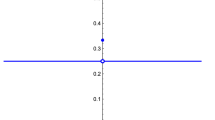Abstract
The total correlations in a bipartite quantum state are well quantified by the quantum mutual information, the amount of which is not necessarily fully extractable by local measurements. The observable correlations are the maximal correlations that can be extracted via local measurements, and have an intuitive interpretation as a measure of classical correlations. We evaluate the observable correlations for generic two-qubit states and obtain analytical expressions in some particular cases. The intricate and subtle relationships among the total, quantum and classical correlations are illustrated in terms of observable correlations. In the course, we also disprove an intuitive conjecture of Lindblad which states that the classical correlations account for at least half of the total correlations, or equivalently, correlations are more classical than quantum.
Similar content being viewed by others
References
Adami, C., Cerf, N.J.: Von Neumann capacity of noisy quantum channels. Phys. Rev. A 56, 3470–3483 (1997)
Barnett, S.M., Phoenix, S.J.D.: Entropy as a measure of quantum optical correlation. Phys. Rev. A 40, 2404–2409 (1989)
Barnett, S.M., Phoenix, S.J.D.: Information theory, squeezing, and quantum correlations. Phys. Rev. A 44, 535–545 (1991)
Bennett, C.H., DiVincenzo, D.P., Smolin, J.A., Wootters, W.K.: Mixed-state entanglement and quantum error correction. Phys. Rev. A 54, 3824–3851 (1996)
Bhatia, R.: Matrix Analysis. Springer, Berlin (1997)
Cover, T.M., Thomas, J.A.: Elements of Information Theory. Wiley, New York (1991)
Cramér, H.: Mathematical Methods of Statistics. Princeton University Press, Princeton (1974)
Einstein, A., Podolsky, B., Rosen, N.: Can quantum-mechanical description of physical reality be considered complete? Phys. Rev. 47, 777–780 (1935)
Everett III, H.: The theory of the universal wavefunction. In: DeWitt, B.S., Graham, N. (eds.) The Many-Worlds Interpretation of Quantum Mechanics, pp. 3–140. Princeton University Press, Princeton (1973) (written in 1957, first publication herein)
Groisman, B., Popescu, S.A.: Winter, Quantum, classical, and total amount of correlations in a quantum state. Phys. Rev. A 72, 032317 (2005)
Hall, M.J.W., Andersson, E., Brougham, T.: Maximum observable correlation for a bipartite quantum system. Phys. Rev. A 74, 062308 (2006)
Henderson, L., Vedral, V.: Classical, quantum and total correlations. J. Phys. A 34, 6899–6905 (2001)
Horodecki, M.: Entanglement measures. Quantum Inf. Comput. 1, 3–26 (2001)
Li, N., Luo, S.: Total versus quantum correlations in quantum states. Phys. Rev. A 76, 032327 (2007)
Lindblad, G.: Entropy, information and quantum measurements. Commun. Math. Phys. 33, 305–322 (1973)
Lindblad, G.: Expectations and entropy inequalities for finite quantum systems. Commun. Math. Phys. 39, 111–119 (1974)
Lindblad, G.: Quantum entropy and quantum measurements. In: Bendjaballah, C., et al.(eds.) Quantum Aspects of Optical Communications. Lecture Notes in Physics, vol. 378, pp. 71–80. Springer, Berlin (1991)
Nielsen, M., Chuang, I.L.: Quantum Computation and Quantum Information. Cambridge University Press, Cambridge (2000)
Ollivier, H., Zurek, W.H.: Quantum discord: a measure of the quantumness of correlations. Phys. Rev. Lett. 88, 017901 (2002)
Peres, A.: Quantum Theory: Concepts and Methods. Kluwer Academic, Dordrecht (1998)
Schrödinger, E.: Discussion of probability relations between separated systems. Proc. Camb. Philos. Soc. 31, 555–563 (1935)
Schumacher, B., Westmoreland, M.D.: Quantum mutual information and the one-time pad. Phys. Rev. A 74, 042305 (2006)
Shannon, C.E., Weaver, W.: The Mathematical Theory of Communication. University of Illinois Press, Urbana (1949)
Vedral, V.: The role of relative entropy in quantum information theory. Rev. Mod. Phys. 74, 197–234 (2002)
Wehrl, A.: General properties of entropy. Rev. Mod. Phys. 50, 221–260 (1978)
Werner, R.F.: Quantum states with Einstein-Podolsky-Rosen correlations admitting a hidden-variable model. Phys. Rev. A 40, 4277–4281 (1989)
Wootters, W.K.: Entanglement of formation and concurrence. Quantum Inf. Comput. 1, 27–44 (2001)
Author information
Authors and Affiliations
Corresponding author
Rights and permissions
About this article
Cite this article
Luo, S., Zhang, Q. Observable Correlations in Two-Qubit States. J Stat Phys 136, 165–177 (2009). https://doi.org/10.1007/s10955-009-9779-0
Received:
Accepted:
Published:
Issue Date:
DOI: https://doi.org/10.1007/s10955-009-9779-0



